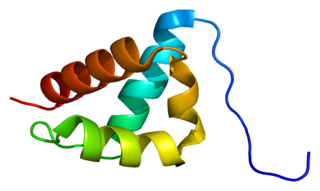
Apoptosis regulator BAX, also known as bcl-2-like protein 4, is a protein that in humans is encoded by the BAX gene. BAX is a member of the Bcl-2 gene family. BCL2 family members form hetero- or homodimers and act as anti- or pro-apoptotic regulators that are involved in a wide variety of cellular activities. This protein forms a heterodimer with BCL2, and functions as an apoptotic activator. This protein is reported to interact with, and increase the opening of, the mitochondrial voltage-dependent anion channel (VDAC), which leads to the loss in membrane potential and the release of cytochrome c. The expression of this gene is regulated by the tumor suppressor P53 and has been shown to be involved in P53-mediated apoptosis.

Bcl-2 homologous antagonist/killer is a protein that in humans is encoded by the BAK1 gene on chromosome 6. The protein encoded by this gene belongs to the BCL2 protein family. BCL2 family members form oligomers or heterodimers and act as anti- or pro-apoptotic regulators that are involved in a wide variety of cellular activities. This protein localizes to mitochondria, and functions to induce apoptosis. It interacts with and accelerates the opening of the mitochondrial voltage-dependent anion channel, which leads to a loss in membrane potential and the release of cytochrome c. This protein also interacts with the tumor suppressor P53 after exposure to cell stress.

Caspase-7, apoptosis-related cysteine peptidase, also known as CASP7, is a human protein encoded by the CASP7 gene. CASP7 orthologs have been identified in nearly all mammals for which complete genome data are available. Unique orthologs are also present in birds, lizards, lissamphibians, and teleosts.

Bcl-2-like 1 or BCL2L1 is a human gene. Through alternative splicing, it encodes both of the human proteins Bcl-xL and Bcl-xS.

Caspase-10 is an enzyme that, in humans, is encoded by the CASP10 gene.

Serine/threonine-protein kinase 4 is an enzyme that in humans is encoded by the STK4 gene.

Frizzled-7 is a protein that in humans is encoded by the FZD7 gene.

Frizzled-10 is a protein that in humans is encoded by the FZD10 gene. FZD10 has also been designated as CD350.

Double-strand-break repair protein rad21 homolog is a protein that in humans is encoded by the RAD21 gene.

Pre-mRNA-processing factor 40 homolog A is a protein that in humans is encoded by the PRPF40A gene.

MAP kinase-activating death domain protein is an enzyme that in humans is encoded by the MADD gene.

Apoptosis regulatory protein Siva is a protein that in humans is encoded by the SIVA1 gene. This gene encodes a protein with an important role in the apoptotic pathway induced by the CD27 antigen, a member of the tumor necrosis factor receptor (TFNR) superfamily. The CD27 antigen cytoplasmic tail binds to the N-terminus of this protein. Two alternatively spliced transcript variants encoding distinct proteins have been described.

KIAA1967, also known as Deleted in Breast Cancer 1, is a protein which in humans is encoded by the KIAA1967 gene.

Serine/threonine-protein kinase 3 is an enzyme that in humans is encoded by the STK3 gene.

THO complex subunit 1 is a protein that in humans is encoded by the THOC1 gene.

CREB regulated transcription coactivator 2, also known as CRTC2, is a protein which in humans is encoded by the CRTC2 gene.

Transcription factor MafA is a protein that in humans is encoded by the MAFA gene. It is a member of the Maf family of transcription factors.

SFRS2-interacting protein is a protein that in humans is encoded by the SFRS2IP gene.

Caspase-activated DNase (CAD) or DNA fragmentation factor subunit beta is a protein that in humans is encoded by the DFFB gene. It breaks up the DNA during apoptosis and promotes cell differentiation. It is usually an inactive monomer inhibited by ICAD. This is cleaved before dimerization.

Guanine nucleotide-binding protein G(t) subunit alpha-3, also known as gustducin alpha-3 chain, is a protein that in humans is encoded by the GNAT3 gene.






















